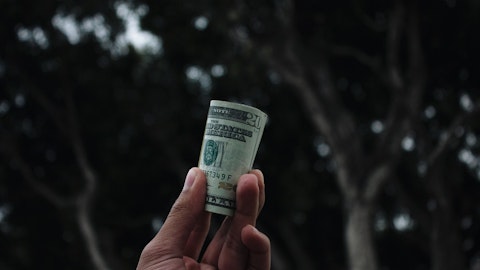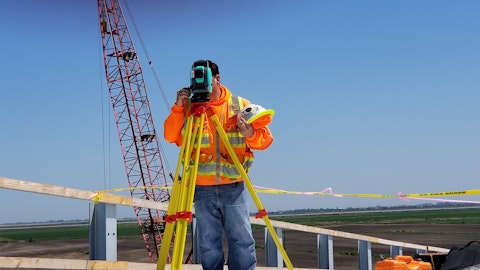ChampionX Corporation (NASDAQ:CHX) Q3 2023 Earnings Call Transcript October 25, 2023
Operator: Good morning. Welcome to ChampionX Corporation’s Third Quarter 2023 Earnings Conference Call. Your host for this morning’s call is Byron Pope. I will now turn the call over to Mr. Pope. You may begin.
Byron Pope: Thank you. Good morning, everyone. With me today are Soma Somasundaram, President and CEO of ChampionX and Ken Fisher, our Executive Vice President and CFO. During today’s call, Soma will share some of our company’s highlights. Ken will then discuss our third quarter results and fourth quarter outlook before turning the call back to Soma for some summary thoughts. We will then open the call for Q&A. During today’s call, we will be referring to the slides posted on our website. Let me remind all participants that some of the statements we will be making today are forward-looking. These matters involve risks and uncertainties that could cause material difference in our results from those projected in these statements.

A worker in a factory assembling a pump package, to the exact specifications of the customer. Editorial photo for a financial news article. 8k. –ar 16:9
Therefore, I refer you to our last 10-K filing and our other SEC filings for a discussion of some of the factors that could cause actual results to differ materially. Our comments today may also include non-GAAP financial measures. Additional details on reconciliations to the most directly comparable GAAP financial measures can be found in our third quarter press release, which is available on our website. I will now turn the call over to Soma.
Soma Somasundaram: Thank you, Byron. Good morning, everyone. I would like to welcome our shareholders, employees and analysts to our third quarter 2023 earnings call. Thanks for joining us today. We demonstrated the benefits of our geographically diversified portfolio in the third quarter as we delivered adjusted EBITDA growth and margin expansion despite some near-term cross-currents in our short cycle U.S. land businesses. We once again delivered robust free cash flow generation and returned excess capital to our shareholders. I’m appreciative of all our employees for their focus and tireless dedication to delivering value to our customers day-in and day-out. On Slide number 4, we begin our earnings call with our corporate vision, purpose, and operating philosophy because we wake up every day committed to improving the lives of our customers, our employees, our shareholders, and our communities.
On Slide number 5, we share one example of the many types of ChampionX innovation, which emerged from being relentless advocates for our customers and delivering technology with impact. Our SOOFIE continuous emission monitoring system, which was designed from the ground up to be an effective and accessible solution for our continuous monitoring of onsite methane emission detection. And this case study illustrates how our SOOFIE system helped one of our customers detect and avoid a catastrophic leak at one of its production facilities in real-time, resulting in environmental and financial savings. Our AURA optical gas imaging, or OGI camera is a natural complement to our SOOFIE system and is designed to help our customers meet current and future emissions monitoring needs by accurately detecting and documenting even small methane leaks.
Now turning to third quarter performance, our third quarter revenue increased 1% sequentially as strong international growth in our Production Chemical Technologies and Production & Automation Technologies businesses were largely offset by lower activity in U.S. land, driven by lower drilling and completions activity. In Q3 U.S. rigs declined almost 10% sequentially and U.S. completions activity declined over 9% sequentially impacting revenues in our drilling technologies and PAT segments. Our digital revenues increased 17% year-over-year. We remain highly encouraged by the continued strong adoption of our fit-for-purpose digital solutions, including our emissions management technologies that drive tangible productivity and sustainability benefits for our customers.
Our continuous emissions monitoring technology installations continue to grow along with the recurring revenues. Today, more than 60 customers use our SOOFIE continuous emissions monitoring technology. We continue to deliver strong EBITDA performance. During the first nine months of 2023, our adjusted EBITDA grew 28% year-over-year, and our adjusted EBITDA margin expanded 437 basis points compared to the first nine months of 2022. Ken will take you through the details of our third quarter financial results shortly, but let me first touch on three key business highlights, which are shown on Slide number 6. First, EBITDA margin expansion, despite experiencing $7 million of foreign exchange losses related to Argentina currency devaluation, we delivered an adjusted EBITDA margin of 20.2% in the third quarter, which represents our six consecutive quarter of sequential adjusted EBITDA margin improvements.
Based on the midpoint of our Q4 guidance for full year 2023, we will deliver an adjusted EBITDA margin expansion of 370 basis points compared to 2022. We remain confident in our ability to further expand our adjusted EBITDA margin as we step through 2024. Second, free cash flow. We delivered another strong free cash flow quarter having generated free cash flow of $115 million, which represented 60% of adjusted EBITDA. This further demonstrates the best-in-class free cash flow generating capability of a capitalized portfolio of businesses, and illustrates our high degree of confidence in converting at least 50% of EBITDA to free cash flow in 2023 and delivering between 50% to 60% conversion of EBITDA to free cash flow through the cycle. We expect our free cash flow to continue to grow in the coming years driven by EBITDA growth and margin expansion.
Third, returning capital to shareholders. Our disciplined capital allocation framework is designed to create value for our shareholders. And in the third quarter, we once again delivered on our commitment to return excess cash to our shareholders. In the third quarter, between our regular cash dividend of $17 million and $68 million of share repurchases, we returned 74% of our free cash flow to shareholders. Since we began our capital return program in the second quarter of 2022, we have returned $434 million of capital to shareholders through dividends and stock repurchases. This represents 66% of the free cash flow generated during the same period. We expect our capital returns to grow as we grow over free cash flow in the coming years, and we remain committed to return at least 60% of free cash flow to our shareholders this year and through the cycle.
Let me now turn the call over to Ken to discuss our third quarter results and our fourth quarter outlook.
Ken Fisher: Thank you, Soma. Good morning and thank you for joining us today. I will be commenting on adjusted EBITDA for sequential and year-over-year comparison. We believe this metric best reflects the business performance of continuing operations. Our third quarter 2023 revenue was $940 million, up 1% versus our second quarter 2023 revenues, while 8% lower than third quarter of 2022. On a geographic basis, sequentially North America and international revenues were up 1% and 2%, respectively. Drilling down, overall U.S. revenues were flat quarter-over-quarter with PCT up 6% and PAT and PDC down 3% and 7% respectively. Meanwhile, the rest of the world revenues were up 3% sequentially driven by solid growth in PCT and PAT. Year-over-year North American revenues declined 2%, while international revenues were 17% lower.
In the third quarter, our largest business Production Chemical Technologies generated solid sequential revenue growth of 5% with both North America and international contributing positively. With declining U.S. rig count and lower new well complete and activities, our shorter cycle U.S. land businesses were impacted in the quarter with production and automation technology revenues up slightly at 1% and drilling technologies down 4% versus the second quarter of 2023. As previously communicated sales to Ecolab under the cross sales agreement ended with the passing of the third anniversary of our merger date. As such, any sales to Ecolab are now reported in the Production Chemical Technologies segment and no longer reported in corporate and other.
Third quarter GAAP net income for the company was $78 million or $0.39 per diluted share versus $96 million in the second quarter and $23 million in the third quarter of 2022. As seen on Slide 10, ChampionX consolidated adjusted EBITDA in the third quarter was $190 million up 2% versus the previous quarter, and a 14% increase year-over-year. Third quarter adjusted EBITDA included the impact of approximately $7 million of foreign exchange loss related to devaluation of our peso exposure in Argentina during the period. In the third quarter, ChampionX delivered a strong consolidated adjusted EBITDA margin of 20.2%. This was up seven points sequentially and up 391 basis points over the third quarter of 2022. Our third quarter free cash flow of $115 million reflected strong cash flow from operations and our continued focus on working capital management.
The $115 million represented 60% conversion of free cash flow from adjusted EBITDA. Cash from operating activities was $163 million and capital investment was $48 million net of proceeds from asset sales. Production Chemical Technologies generated third quarter revenue of $604 million, up 5% from the second quarter and 6% lower year-over-year. Sales were strong in North America and internationally where respective revenues were up 5% and 6% sequentially. Segment adjusted EBITDA was $125 million, up 7% sequentially and 22% higher than the third quarter of 2022. The third quarter segment adjusted EBITDA was adversely impacted by the aforementioned $7 million Argentina foreign exchange loss during the period. Sequentially, we saw a positive impact from higher volumes and productivity projects.
Volume growth increased selling price and productivity projects drove the strong year-over-year improvement. Segment adjusted EBITDA margin was 20.7%, up 37 basis points sequentially and up 472 basis points from the prior years’ period, driven again by the higher volume selling prices and the productivity initiative previously noted. Production and Automation Technologies third quarter segment revenue of $256 million, increased 1% sequentially. Year-over-year PAT revenue was up 3%. Geographically, international revenue increased 9% sequentially, while North America revenue was down 1%. Digital revenues, which can exhibit some lumpiness quarter-to-quarter were down 4% sequentially while increasing 17% year-over-year. We continue to see increased customer focus on implementing digital and emissions technologies to reduce emissions and drive operational and cost improvements.
We remain very excited about expected future revenue growth from digital, including our emissions offering. PAT third quarter segment adjusted EBITDA was $59 million, lower 2% sequentially, while up 14% year-over-year. Segment adjusted EBITDA margin was 23.2%, down 73 basis points versus the second quarter and up 213 basis points from the prior year due to higher volumes and selling prices. Drilling Technologies segment revenue was $55 million in the third quarter, down 4% sequentially and down 10% year-over-year with both declines driven by lower U.S. land rig count activity. Drilling Technologies delivered segment adjusted EBITDA of $14 million during the third quarter flat sequentially and down $3 million compared to the third quarter of 2022.
Segment adjusted EBITDA margin was 25.1% in the quarter flat sequentially. Reservoir Chemical Technologies revenue for the third quarter was $25 million, up 5% sequentially and a 29% decrease year-over-year. As previously discussed, the year-over-year revenue decline was driven by the exit of certain low margin RCT product lines last year. This exit resulted in lower revenues, but a significant improvement in the margin profile of this business. The segment posted adjusted EBITDA of $4 million during the third quarter. Flat was second quarter and up $1.5 million versus the corresponding prior year period. Segment adjusted EBITDA margin was 16.6% in the quarter, a 110 basis points sequential decline. Year-over-year, the segment margin increased 914 basis points driven by the product line exit and related restructuring actions.
Moving to our balance sheet, as shown on Slide 11, we again ended the third quarter in a very strong position with liquidity of $954 million, including $285 million of cash on hand and our available revolver capacity. At September 30th, our net leverage ratio was 0.4x net debt to trailing 12-month adjusted EBITDA. In alignment with our capital allocation framework, we remained committed to the return of surplus capital to our shareholders. During the third quarter, we returned approximately 74% of quarterly free cash flow to shareholders, including $17 million in regular quarterly dividends and $68 million of share repurchases. Year-to-date, we have returned 76% of free cash flow to shareholders. Moving forward, expect us to continue our disciplined capital allocation process and our focus on delivery of operating and free cash flow, along with continued improvement in working capital management.
We will also focus on maintaining our robust liquidity level and a strong financial position, enabled to continue returning at least 60% of free cash flow to shareholders. As we continue to drive disciplined capital allocation and continuous improvement in productivity, as you can see on Slide 12, we continue to improve our return on invested capital or ROIC. We are making good progress toward our targeted 20% plus ROIC. Our trailing 12-month ROIC has improved to 17%, up approximately 400 basis points over the 2022 full-year actual rate. Now turning to Slide 13. In our forward outlook for fourth quarter, we expect revenue in the range of $930 million to $970 million. The projected fourth quarter revenue sequential change is primarily driven by continued positive momentum in our international businesses, offset by expected seasonal slowdowns in our North American businesses as they move into the year-end holidays.
We expect our drilling technology business to experience a sequential revenue decline similar to that of the fourth quarter of 2022, as some of our customers act to manage their working capital and free cash flow into year-end. For adjusted EBITDA, we expect a range of $187 million to $197 million, which at the midpoint represents a 7% increase over the fourth quarter of 2022. At the midpoint, this represents an approximate 200 basis points improvement year-over-year in the company’s adjusted EBITDA margin rate. Please note for clarity, this fourth quarter adjusted EBITDA guidance does not anticipate any further significant devaluation in the Argentine peso during the period. Moving forward, we remain confident in our 50% to 60% free cash flow to adjusted EBITDA conversion ratio guidance through the cycle, and we expect a free cash flow ratio of at least 50% for fourth quarter and the full year of 2023.
Thank you, and now back to Soma.
Soma Somasundaram: Thank you, Ken. Before we open the call to questions, let me share a few thoughts with you. As a leading global provider of production optimization solutions for the energy industry, we are particularly well positioned to help our upstream and midstream customers, maximize the value of their producing and operating assets in a sustainable and cost-effective way. Despite the short-term softness we are experiencing in our short-cycle U.S. land businesses, we expect U.S. activity to start growing in early 2024 as customer budgets reset. We remain confident in the favorable demand tailwind for our businesses in 2024 and beyond. We are laser-focused on delivering solid bottom-line growth, adjusted EBITDA margin expansion, and strong cash generation, and we remain fully committed to creating value for our shareholders through our disciplined capital allocation framework with crystal-clear priorities for capital deployment, which includes high return investment and returning excess cash to our shareholders.
With that, I would like to thank all of our 7,300 ChampionX employees around the world for their tireless and inspiring commitment to our purpose of improving the lives of our customers, our employees, our shareholders, and our communities. I am honored and humbled to lead such a purpose-driven team. With that, I would like to open the call for questions.
See also 20 Most Overpaid Jobs in the World and 20 Best Value Investing YouTube Channels.
Q&A Session
Follow Championx Corp (NYSE:CHX)
Follow Championx Corp (NYSE:CHX)
Operator: Thank you. [Operator Instructions] Your first question comes from the line of Stephen Gengaro from Stifel. Please go ahead.
Stephen Gengaro: Thanks, and good morning, everybody. Can you help us maybe understand your fourth quarter expectations a bit? I’m sort of thinking about what’s normally a margin improvement in production chemicals, and I understand the North American softness in some of the other areas. But can you kind of help us understand a little bit, maybe on a segment basis the margin progression you’re looking at?
Soma Somasundaram: Yes. Good morning, Stephen. So, when you look at the Q3 to Q4 margin progression, we expect PCT, given the resilience of PCT and seasonal improvement in the international business in PCT. We expect PCT margins to perform well in Q4, compared to Q3. You should see, it had a strong performance in Q3.You should see similar performance are even slightly better in Q4. And I think, Stephen, this will be an important time also to talk about this Argentina devaluation, and so I’ll – as I finish my comment, I’ll ask Ken to talk about that, because that impacted the Q3 margin for us. When it comes to PAT and drilling technologies, when you look at PAT, we do expect sequentially the business to be softer in U.S. land.
And we saw as we exited September. So when we entered Q3 and how we exited September, we could see in September the weakness getting more pronounced in the U.S. land activity in September. And so we do expect that as we go into the Q4, the normal seasonal slowdown will be fully present. We saw some signs of that already starting to happen in September. And it is also the mix in PAT, as you know the completion side is primarily – ESP is driven more by the completion side, so tends to be a higher margin in the PAT side. So that along with some slowdown in the hardware digital purchases in Q4, I think, so that mix will impact PAT. So which means we will see Q3 to Q4 PAT margin to be somewhat down. And then when you look at the DT, DT is where we are going to see bigger impact.
And this is going to be very similar to, because the conversations with customers are very similar to the type of conversation that happened last year. So it’s very clear that particularly our drilling for the – customers of drilling technologies are very – starting to get very focused on Q4 working capital management. And we have already received calls to push out deliveries and those type of conversations are already happening. So that’s why we expect our drilling technologies business to be impacted. If it is similar to last year, you can imagine it could be sequentially down as much as 11%, 12%. So as that business decrements higher so you should expect the drilling technologies business to be down. Now, having said all this, Stephen, I would say, we see a lot of this type of seasonal slowdown and customers managing working capital towards Q4 to be very temporary issues.
If you look at the quality of the businesses are still very strong, we have still delivered year-over-year strong exit margin improvement, and you will still see strong cash generation, you will still see strong capital returns. So these, we see these as temporary U.S. land weaknesses which we are experiencing, which started towards the end of the third quarter and then now we see it playing out in the fourth quarter. So we expect 2024 – as we enter into early 2024, we expect the budgets to reset and we are confident it will be another year of positive growth in U.S. land as well as globally. So with that, I do want Ken to talk about Argentina devaluation, just to, because since it impacted our Q3 margin. So Ken?
Ken Fisher: Yes. Hi, Stephen, the PCT business historically has done business in Argentina profitably. We have roughly about $100 million in annual sales there. We had some questions around the devaluation impacts, so I wanted to be clear about that. It’s not really a revenue issue in that we’re U.S. dollar functional accounting there and we have – many contracts are essentially indexed to the dollar so that when we invoice, we invoice at the current rate then. But the issue was that historically we’ve been, as primarily a product supplier, we’ve been able to repatriate monies to the U.S. out of Argentina regularly and so it had never been an issue before, but late last year and then through this year, we’ve seen the government make a series of changes to both regulation and practice that’s delayed repayments to us and delayed our ability to repatriate.
And so we had built up a balance with the peso exposure in the country that then right after the election, they changed the exchange rate and we were hit with the loss that we noted. So in the meantime, we’ve been working to mitigate that through trying to minimize that balance as much as possible. We have curtailed a little business and then we’re negotiating and, in fact have some customers agree to start to pay us outside of the country in U.S. dollars. So we’ll continue to work that exposure down here over the next couple of quarters. As of this week, it’s about a $15 million exposure, so should there be another significant devaluation, we would have an issue but we’re working hard to minimize it.
Soma Somasundaram: And I think, Stephen, as you know, some of the companies have approached us to do a blue chip swap, which results in a major write down.
Ken Fisher: Yes. Maybe that’s a good point. A lot of the peers in the group are primarily providing services, so historically they were less able to repatriate, and so they built even bigger balances. And they accessed a parallel market called the blue chip swap and took big losses. They excluded those losses from their EBITDA. We treat FX today as part of normal adjusted EBITDA where you get some small gains and losses each period, but we don’t exclude it. But some of the peers took some pretty substantial write-downs on the blue-chip swaps at late last year and early this year because they built up even more significant balances. Because we’re a product provider, we are able to repatriate normally the government actions recently have been adverse and not very appreciated, I guess, I’d say. So hopefully that helps give some color.
Stephen Gengaro: Yes, that does. Thank you. Just one quick follow-up for me, and that is when I think about the sequential PCT margin performance in 4Q, is that after taking into account, the seven million, i.e. a cleaner number being flat to maybe slightly up in the fourth quarter?
Ken Fisher: Yeah, so I think the PCT margin in Q4 that’s not contemplate another devaluation and under that scenario, it should be closer to the 21%.
Stephen Gengaro: Got you. Great. Thank you for the details.
Ken Fisher: Thanks, Stephen.
Operator: Your next question comes from the line of Marc Bianchi from TD Cowen. Please go ahead.
Marc Bianchi: Hi, thanks. I wanted to ask another one on this Argentina situation, because it seems like if you’re going to have 21% margins here in PCT in fourth quarter, there really isn’t any operating leverage in the business. Because you’re just sort of recapturing the absence of the $7 million hit in the third quarter. Are there some other cross-currents that are worth pointing out? Or maybe I’m not reading that right?




